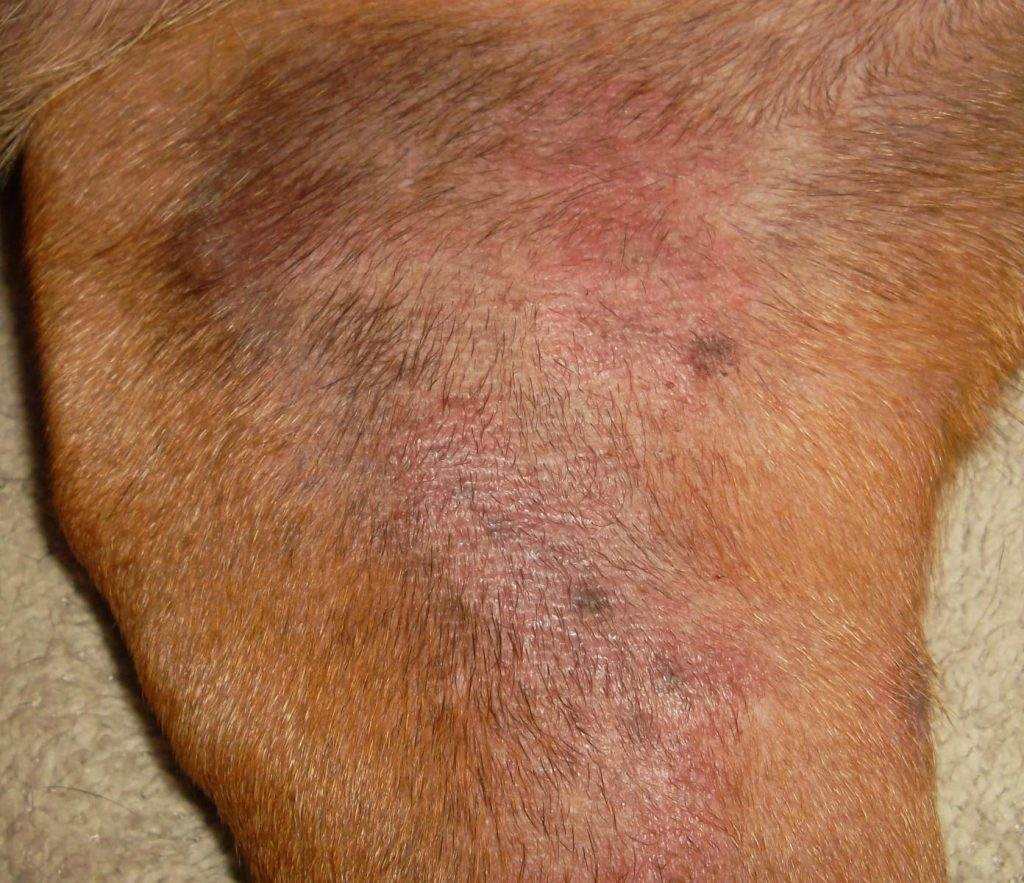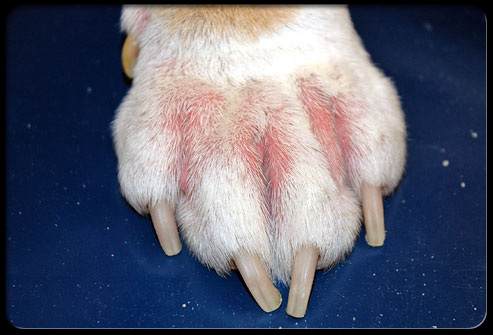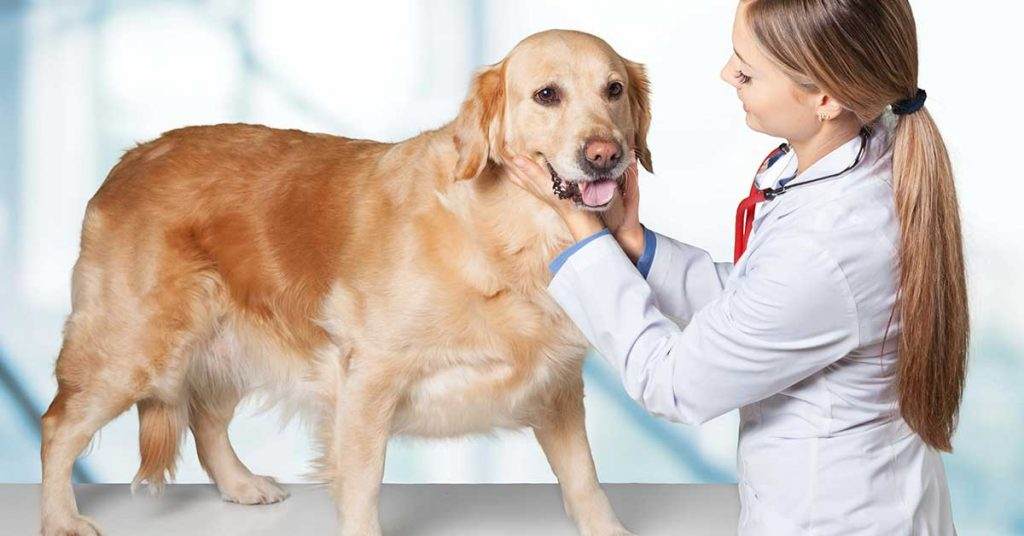Well, yes. Your little guy / girl can develop a skin yeast infection, or Yeast Dermatitis. The cause of Yeast Dermatitis is the fungus: Malassezia pachydermatis. This type of yeast affects the ear canals, skin folds, and other hot and humid parts of your dog’s body.
Generally, this yeast lives on the skin of your dogs and inside their gut, and is usually harmless. However, like all things, its overgrowth causes trouble i.e. the infection.

Causes for Yeast Infection in Dogs
Yeast Infection in dogs, is essentially, an inflammatory skin condition that your little guy/girl experiences frequently. Although, it is not without a cause. Down below are some of the major triggers:
- Shaving the fur too closely
- Scratching (from ticks, fleas, allergens or other irritation)
- Improper Diet
- Exposure to hot, humid weather
- Skin Folds
- Oatmeal shampoos
- Carbohydrates or sugar in food
- Chemotherapy
- Use of a medical catheter
- Some breeds are also predisposed to developing yeast infection. For example- Shih Tzu, American Cocker Spaniels, Poodles, Dachshunds.
Further, dogs whose immune systems have been exposed to a lot medication are prone to developing yeast infection; especially if your buddy is on antibiotics or steroids.
Neither Antibiotics nor steroids cause yeast infection; however, being exposed to both of these help yeast population to proliferate and as a result, cause yeast dermatitis.
Symptoms for Yeast Infection in Dogs
Now, once the over-growth of yeast is triggered, the body of your dog tries to get the yeast level back to the normal. As a result, the symptoms of yeast infection pop up.
However, the symptoms of Yeast Dermatitis is specific to the area of the body it infects. The most common areas of a yeast infection in your buddies are: skin folds, ears, between the paw pads, on the nasal folds, anal area, armpits, and neck.
Thus, the hot and humid regions of your dog’s body are prone to yeast infection. The symptoms for Skin Yeast infection are as follows:
1) Excessive Licking / Scratching
This is one of the first and most prominent symptoms of a Yeast Infection. If you observe your dog excessively scratching, biting or licking a particular area of his body, you must check the skin of that area under the fur. Since yeast infection often occurs inside the ear canal, excessive shaking of the head can also be taken as a symptom.
2) Change in the Colour of the Skin
Yeast Infection also causes the skin to change colour. The skin of the affected area can either get red or dark in colour. Look for pink / darkened spots on the coat of your furry friend. Additionally, the area can swell up and sometimes is warm to touch.
3) Bad odour
Like the type of yeast in food, the yeast on your dog’s skin also creates a foul smell. So, if you smell a different, foul odour coming out of a particular region of your dog’s body, check for other symptoms of yeast infection; or take him / her to the vet right away.

4) Hair Loss
Now, this symptom is associated with other illnesses as well. The hair of your dog start falling after or due to the excessive scratching, licking or chewing of the skin.
5) Greasy, Crusty, or Scaly Coat
If your dog’s luscious coat is looking or feeling greasy/crusty/scaly, checking for yeast infection on his / her body should be the next step.
6) Self-inflicted wounds
Due to the discomfort the yeast infection causes to your buddy, he might chew or scratch himself excessively resulting in self-inflicting wounds.
7) Sticky or yellow/green discharge
If you see a sticky yellow or green discharge on your dogs skin on anywhere on his body, you should try and look for yeast infected areas on your dog’s skin; preferably with gloves on.
8) Recurring Infection in the Ear
Yeast Infection in the ears are pretty common and thus, if your dog suffers from repetitive infections in the ear, take him to the vet. You can either use oral or topical medications.
However, it must be noted that the aforementioned symptoms can also point to other conditions, both individually and collectively. Upon observing any of the symptoms listed above, the best recourse is to get the condition diagnosed.
Diagnosis for Yeast Infection in Dogs
The vet can diagnose yeast infection by taking a few tests. Usually by cytology or by culturing. Often hair samples and skin samples from the affected area are taken for the tests. Some of the widely used techniques are listed down below:
- Scraping – The vet scraps the skin with a blade to check for the infectious agents.
- Impression Smear – In this technique, the vet would press a microscope slide on the skin to identify yeast organisms.
- Cotton Swab Sample
- Acetate Tape Preparations – A tape would be stuck on the affected area and carefully stripped away to collect yeast organisms.
- Skin Biopsy – This technique is the most invasive, but it yields exhaustive results. In Skin Biopsy, the vet takes a small piece of skin with a biopsy punch.
Treatment for Yeast Infection in Dogs
The treatment for this condition can be both oral and topical; depending on the severity of the condition in your dog and his / her underlying conditions. Nonetheless the first step towards structuring the treatment is to identify the cause.
1) Topical Treatments
Topical treatment for yeast infection includes anti-fungal shampoos, Medicated shampoos, anti-fungal ointment or cream. Shampooing your furry buddy with a medicated shampoo would essentially take away the oiliness or greasiness. That should be followed up with a second bath with an anti-fungal shampoo, preferably with chlorhexidine, miconazole, or ketoconazole. However, it must be noted that the shampooing should be done for at least 10 minutes for the anti-fungal shampoo to work its magic. The frequency of this treatment depends on the vet’s advise.
Now, the anti-fungal creams to be used should, preferably, be prescribed by the vet. However, if you are buying one yourself look for these ingredients: Miconazole and ketoconazole. The anti-fungal creams are usually prescribed when the infection is limited to certain spots and the ointment is often advised to be applied every day.
2) Oral Treatment
Oral medications for inflammation can be used to control swelling. However, usually, oral treatment is prescribed if the topical treatments don’t work out. The medications include ketoconazole, itraconazole, and fluconazole.
More importantly, your dog must be given prescribed medication only. It is highly advised to not give over-the-counter medications to your pet.
3) Home Remedies
Although, you must take your pet to the vet for the diagnosis and understanding the cause of the yeast infection, yet administering a few harmless home remedies can help in the treatment and even prove to be preventive.
Apple Cider Vinegar
Massaging apple cider vinegar around the entire body after a swim or a bath controls the yeast outbreak. Apple cider vinegar also helps maintain the pH levels of your dog’s skin.
Coconut Oil
Warm coconut oil mixed with lavender oil and lemon essential oil and massaging the affected areas once a week (or more) help soothe the skin and comfort your dog.
If these remedies don’t work out for your fur friend, you can try yogurt, kefir, tea tree oil, colloidal silver, and oregano oil.
Preventive Measures

There are ways you can prevent the over-population of yeast. These measures are especially beneficial for the breeds that are more prone to developing yeast infection. Some general measures are listed below:
- Baths
One of the best preventive steps is to dry your dog completely after a bath or a swimming session. Because yeasts thrive in humid regions mostly. So bathing your dog with medicated shampoos or applying apple cider vinegar after a bath can go a long way.
- Diets
Controlling or changing the diet of your dog is also crucial for controlling yeast population. Like, include meat and exclude sugary treats from your dog’s diet. Sugar feeds the yeast! Try to avoid table foods and foods rich in carbohydrates like potato, rice.
- Most importantly, observe your dog, his behavior and rub his entire body regularly to catch up on any early signs for yeast infection. This way, you can start treating it even before it has begun to cause any trouble to your furry baby!
Conclusion
Yeast infection is a common illness in dogs and cats as well as humans. It is nothing to be scared about. Nonetheless, consulting a vet is a must for treating it and then following up with the preventive measures and healthy practices like ACV massages, proper drying and a healthy diet!
Table of Contents





